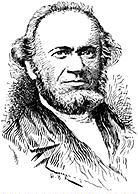I found this interesting
write-up on the web. The author summarizes the debate regarding succession (austritt) from the general community (grossgemeinde) that raged in Germany in the 19th and even 20th centuries; although he favors those that opposed succession and argues in defense of the contemporary multi-denominational Limmud conference. While the write-up is certainly intelligent, reading it, a student of Hirsch can become confused because of the author's leanings. He favors multi-denominational religious conferences. He defends this by naming several German Jewish scholars who opposed succession and saying that a multi-denominational gathering is similar to a grossgemeinde. As he doesn't cite their words, one is tempted to take his word for it. But the mind wonders: Did they all really oppose succession and are the two the same? I am not accusing the man of making up sources, but perhaps reading them with an intent towards a conclusion, as driven by the Jewish heart in its desire for outreach. Beware the heart overtaking reason. The results seem wonderful in the short run, but the long run is another matter. It's like DDT, lead paint, or asbestos. Beware the magical short-term solution.
I'm not saying here that there's nothing good about the Limud conference. Same with Reform Judaism. If it is giving Jews some kind of a Jewish consciousness, then it's doing some kind of good. But should the Orthodox participate and thereby give non-observant practice some credence - that's another question. I'm not saying that I have the final answer to that question. But the concept of Austritt, and I mean post Germany Austritt, would argue against participation.
But the Limud conference isn't the main concern of my post. My concern is the effect of the influence of even Orthodox people on one another. What I find in the article is an argument against Austritt that's serves as an argument for something that perhaps shouldn't be called Austritt, as that has a very specific historical meaning as I have been learning, but perhaps we can call distancing. The author seems knowledgeable and well-meaning - and he likely is both of those things. Accordingly, he is persuasive in a way, and the reader may find himself buying into the argument. But the argument is superficial and unless you have time to really pick it apart, it can influence you. The mind is pliable and takes on different modes of thought, different outlooks, different personalities. We can take on different identities in life.The mind switches. This is how you get debate, how you get people on completely different sides of the fence. The mind is an amazing instrument, but most minds limit themselves to singular outlooks. We can use this power of change for the good, but we can allow it to confuse us too and take us to problematic places. We piece together arguments and facts and experience it as the truth. In our youth, we are particularly vulnerable. Isn't this what happened to the many people who left Torah observance in modern times? They took on a new identity, one with its own arguments, symbolism, and feeling, but one that was so tragic.
All of this is exactly why you need a kind of distancing in our day and age not only with the non-religious elements, as they are so far away from Orthodoxy, but with groups that have absorbed excessive amounts of problematic secular attitudes. By this I'm not talking about friendship or neighborliness. I'm talking about a mental distancing where one is careful to hold onto his or her vision and ideals. Problematic groups (and they can be on the right or the left or the center) speak a language similar enough to be persuasive but take one to the wrong places. You wind up confused, diffused, and weakened in your derech. Examples of this include the halahkic radicalism that has taken over parts of the frum community due to feminism. The same applies to the influx of rap and rock music that one finds in simchas. Once you open the gates to secular music, how do you keep out the rap? You have to be very careful. And when you associate excessively, or organizationally, with groups that are not careful, you lose your discipline.
In the end, it comes down here to trusting in your gadol. If R' Breuer and R' Schwab advocated distancing, which post Germany meant distancing oneself from official organizational association in theological matters with religious groups that themselves are hooked into non-religious groups or even religious ones who have taken on excessive amounts of secular attitudes, then one must trust them, their wisdom, their tzidkus, and their experience. They speak from a mesorah. As R' Hirsch told us often, Torah differs from science in that we rely on a mesorah, a tradition, a revealed truth, rather than one that is the product only of observation and reason, a home-grown truth, so to speak. You can grow your own tomatoes at home, but don't try growing your own penicillin.
The Torah Im Derech Eretz person needs this general distancing more than the Charedi. One reason Chabad sluchim hold on so well even in remote communities is because they look, dress, and think so differently from their environs that they are much less at risk from absorbing negative attitudes then a Torah Im Derech Eretz person would be, as TIDE people are by definition open to the positive parts of the general culture. This is why the Torah Im Derech Eretz needs to be able to distance him or herself. If you are going to be open, then you have to know how to close the door.



